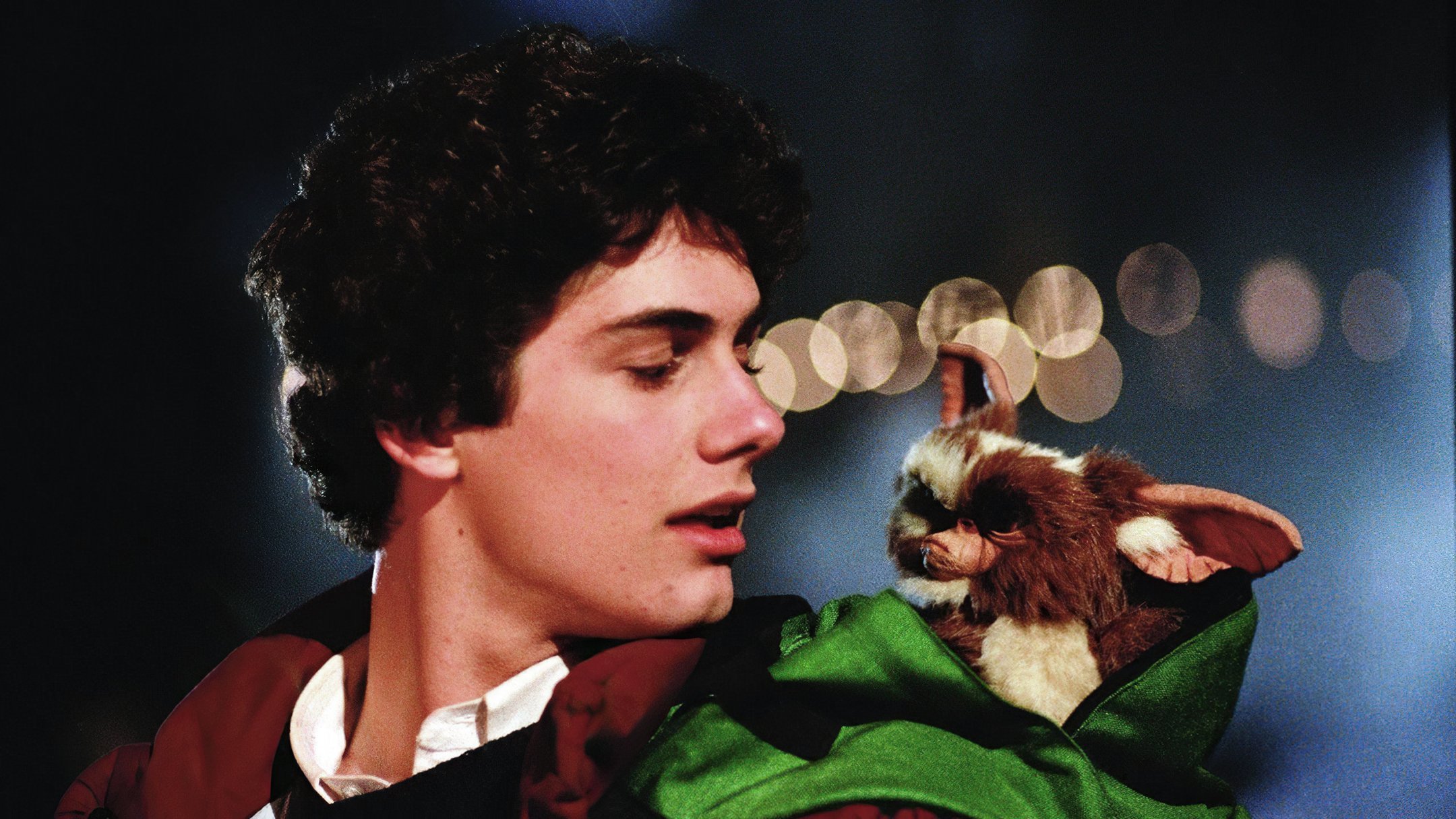
John Hora and Gremlins
The cinematographer details his most complex and ambitious production to date.
With Gremlins, director Joe Dante continues a profitable association that first began with executive producer Steven Spielberg on Twilight Zone: The Movie. Described as “E.T. with teeth,” and with a screenplay by first-time scriptwriter Chris Columbus, Gremlins is a cartoonish fantasy concerning the plight of Billy Peltzer (Zach Galligan) whose cute, furry living Christmas present from his father Rand (Hoyt Axton) actually reveals itself to be a “mogwai” — Chinese for devil. If fed after midnight, or immersed in water, the Mogwai self-reproduces into scalier, infinitely more dangerous versions of itself, the gremlins of the film’s title. By story’s end, a veritable horde of these creatures (designed, created and operated by Chris Walas, Inc.) have hopped through and turned upside down Billy’s small hometown of Kingston Falls, a siege during which Dante not only manages to blend humor and horror but also provide a veritable catalog of cinematic in-jokes.
“[Joe] Dante and I have an interesting, comfortable relationship. Perhaps it’s because Joe has the sardonic sense of humor and I have what has been described as an over-developed sense of irony.”
— John Hora, ASC
However, with all the considerable press accorded to Spielberg, Dante and Walas since the film’s release, one key contributor seems to have escaped close attention, Gremlins director of photography, John Hora. No stranger to Dante’s work (Hora had also shot the director’s previous Twilight Zone: The Movie segment titled “It’s a Good Life,” as well as Dante’s The Howling), John Hora was born in Pasadena in 1940. He professes that his “artistic heart and soul lies back in the good, rich, black-and-white days of such films as Night of the Hunter and Mildred Pierce.” A graduate of the USC film school (and ex-roommate of producer Gary Kurtz), Hora had worked on a number of low-budget films in a subordinate capacity before joining the John Urie Company, one of the largest television commercial houses on the West Coast. With nearly ten years of these assignments behind him, Hora had already photographed a great many commercials when he was tapped as DP for his first theatrical feature, 1973’s Big Mo (retitled Maurie for its television release).
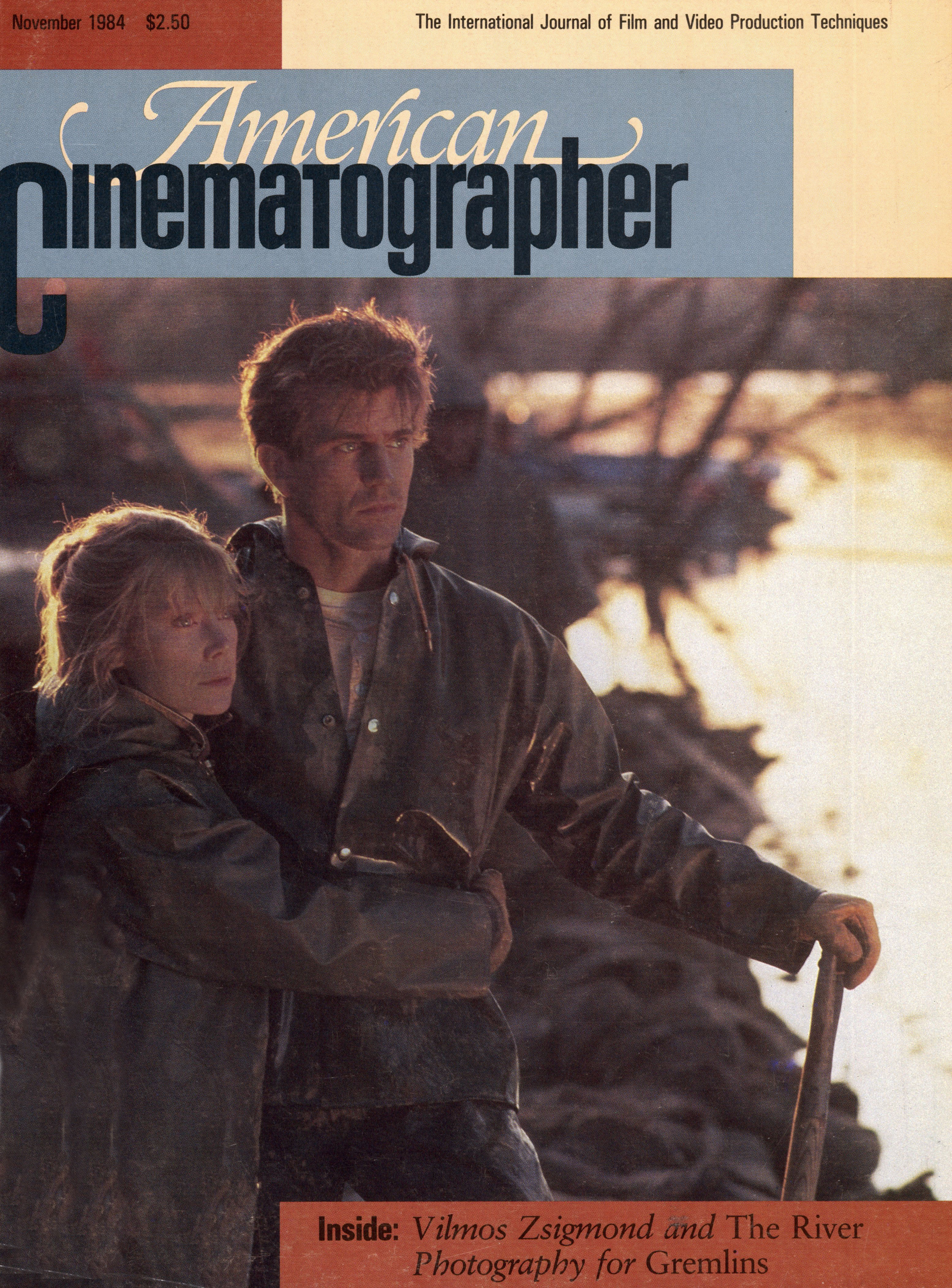
“I had shot both The Further Adventures of the Wilderness Family and a Disney television project called Strange Companion when, one day, I got a call from a producer, Mike Finnell, who wanted to see my work,” Hora recalls. (Finnell not only produced Gremlins but served in a similar capacity for the two earlier Hora/Dante collaborations.) Intrigued, Hora agreed to the request. After screening a product reel composed of the Disney and Wilderness films, Hora was then informed that he had been chosen as the cinematographer on what he now calls “a very different kind of low-budget picture called The Howling.”
Concerning a colony of werewolves hidden away in a trendy Northern California spa/sanitarium, The Howling marked the beginning of an unusually close working kinship between director and cameraman. “Dante and I have an interesting, comfortable relationship,” Hora relates, “perhaps it’s because Joe has the sardonic sense of humor and I have what has been described as an over-developed sense of irony.” Besides bringing him to someone with a related personality, Hora also recalls that The Howling enabled him to add a few tricks to his low-budget filming bag.

“I learned a gimmick on that film which was pretty obvious,” Hora says. “It involved laying down dolly tracks in such a way that you could get four different setups from one piece of work; you’d simply shoot off both sides and each end of the track, after choosing an appropriate site that would support that type of flexibility. This was an important lesson because I was always moving the camera during that production. In fact, if we couldn’t think of another shot, we made it a practice just to truck through the woods on The Howling getting various points of view and retrieving the footage later.”
Production costs on The Howling were low, but Hora found himself working upscale for Gremlins. Yet even with a project totaling $11 million and one associated with such high-powered names as Steven Spielberg, Hora has not appreciably changed his basic philosophy of cinematography. “When I was first doing commercials we were involved in so many outlandish effects — quick moving zooms, fast crane work, knockout shots like packing an automobile with explosives, detonating it while filming at high speeds, and then printing the footage backwards — that I determined then and there that my reputation as a cameraman was eventually going to be based on dignity and caution. “Well,” Hora amusedly recalls, “as I went along and learned my craft, I realized that what I thought was going to be my professional attitude was actually pretty dull stuff.
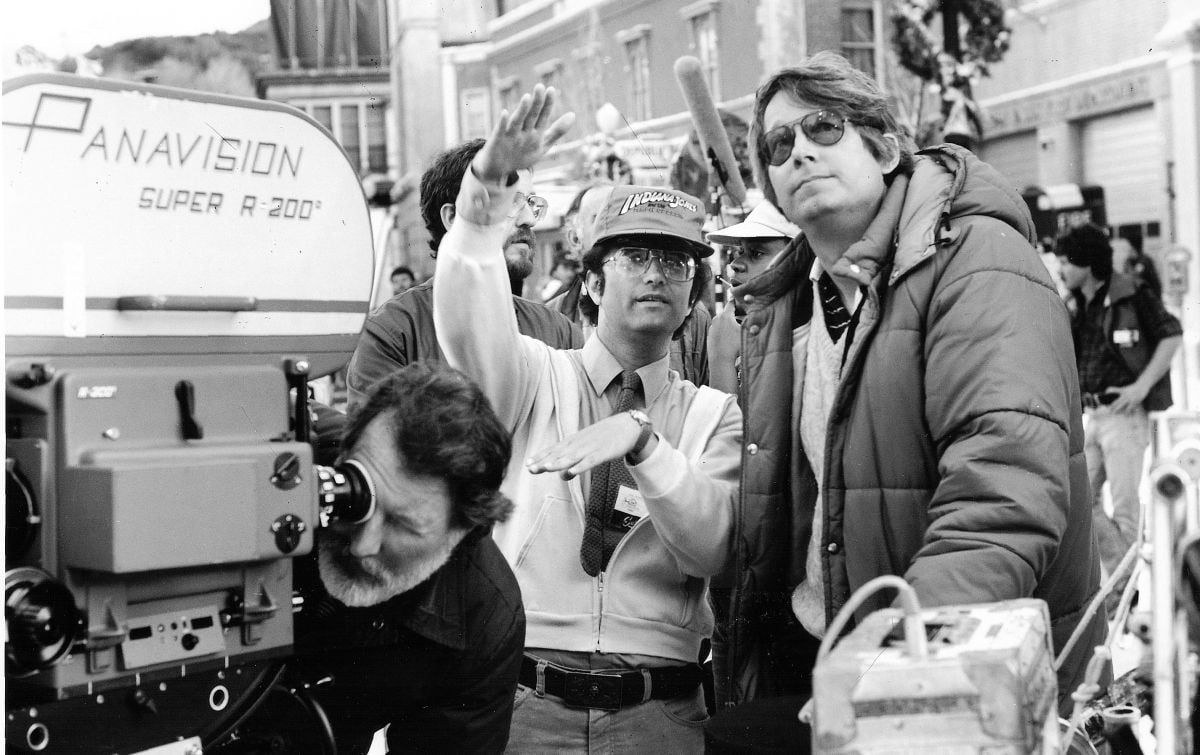
“It was during The Howling that I cemented any ‘philosophy’ I might now have,” continues Hora. “It’s one that basically says, ‘Let’s go much farther with everything.’ And I’ve tried to hold to that. I believe in keeping the camera fluid, in going all out with highly stylized lighting, and I really enjoy what we learned in film school as being called dutch, or canted angles. These are those shots with the camera off-level, the kind that Orson Welles in Touch of Evil, or Carol Reed in The Third Man, or Alfred Hitchcock in The 39 Steps — the first four or five shots of the film are all subtly tilted by about fifteen or twenty degrees — are famous for. I also remember seeing Kazan’s East of Eden in its first release during a period of my own adolescent turmoil, and two things that impressed me about that film were James Dean and its dutch angles. And they are two things that still impress me.”

Interestingly, Hora states that he is unfamiliar with the work of the late Italian horror director Mario Bava, an influence Dante has repeatedly acknowledged. Worked out in semi-obscurity, Bava’s films, although relegated to the exploitation field, nevertheless revealed the assurance of a vigorous stylist. Often serving as his own cinematographer, Bava’s recurrently sadistic themes are awash in a kind of controlled delirious excess, films trademarked by deeply lurid lighting effects and aggressive, striking camera work — camerawork and effects paralleling Hora’s own. “I would have to say that if Bava is indeed an element in my work, then it’s Joe’s input, and not my own,” Hora says. “I haven’t even seen any of his films that I’m aware of.”
However, before any possible influences or philosophies could be applied to Gremlins there was still the matter of coming up with a shootable script. As Hora explains it, “The first draft Gremlins script that Chris Columbus turned in to Mike Finnell was a pretty straightforward horror film, with little humor. Then, only two months before the start of production, Spielberg had a brainstorm. Steven decided that instead of having Gizmo, Billy’s pet mogwai, turn into the major gremlin — which was the original idea —Spielberg wanted Gizmo to become the hero of the piece, to help fight the bad gremlins. This threw Chris Walas and his gremlins effects crew for a loop, because up to this point Gizmo was only in the first third of the story, but now he had to carry the entire film! And Chris and his crew had originally made Gizmo so small that it was impossible to articulate him for walking. Joe’s solution to that was to keep sticking Gizmo into boxes and backpacks, which effectively solved the problem.”
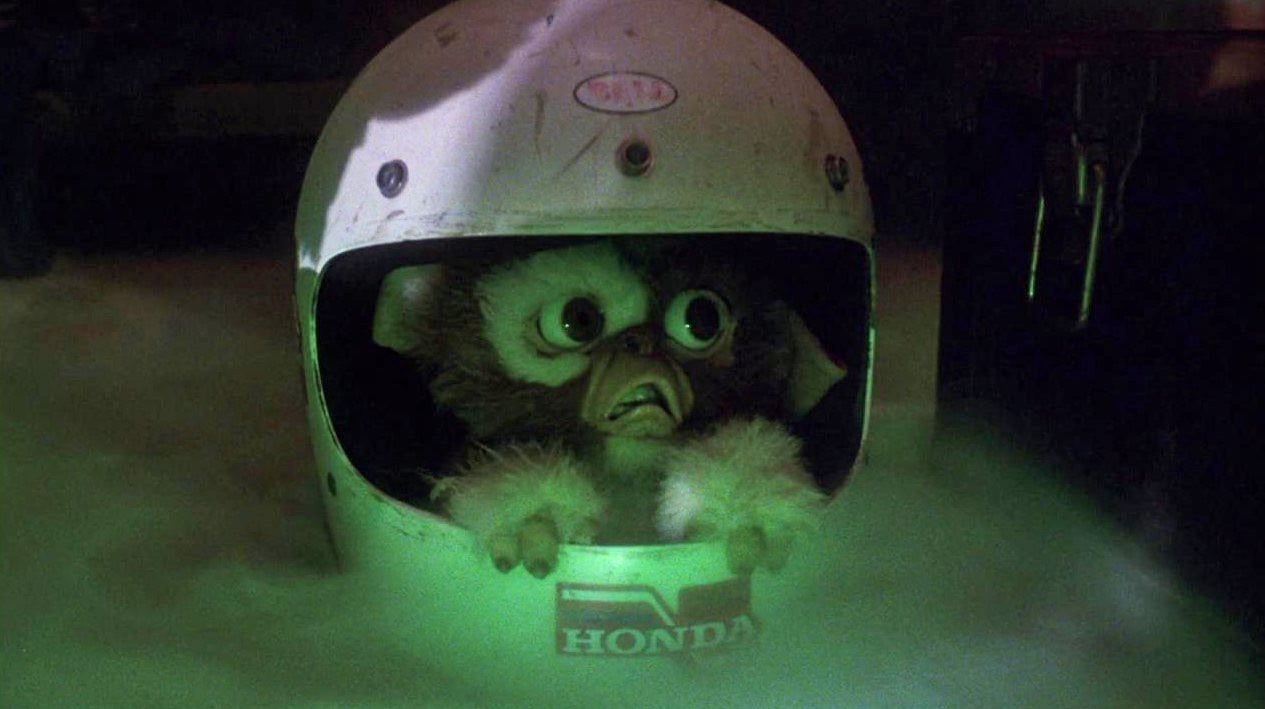
With the Gremlins script now lightened in tone and deepened with effects complexity, the film’s shooting schedule was laid in. Finnell initially received Columbus’ first draft while the former was still involved in the Twilight Zone feature film; subsequently, production on Gremlins began April 27 with principal photography ending August 3 of 1983. After taking a few weeks off, Dante, Hora, and Walas again regrouped for a vigorous period of postproduction, during which virtually all the gremlins effects shots that did not require live actors were filmed.
“Spielberg was still coming up with new ideas, even during post,” Hora comments. “For instance, when all the gremlins are going wild at Dorry’s Tavern near the end of the film, there’s a quick shot of a gremlin break-dancing on his back. That was one of Steven’s last-minute inspirations, and virtually one of the last things shot for the film. It was done as an insert up at ILM [Industrial Light & Magic, George Lucas’ Marin County special effects facility] not long before the answer print was ready.”
Although it had originally intended to use the so-called “Dukes of Hazzard Street” on the Warner Bros. lot for the Kingston Falls exteriors, scheduling delays forced the Gremlins unit to move to Universal Studios’ Town Square set for these sequences of the film. The Columbia Ranch provided the exteriors for the homes of the Futtermans (played by long-time Roger Corman alumni Dick Miller and Jackie Joseph) and the Peltzers. The Ranch also has an outdoor swimming pool which, by the addition of two walls, became the location for the interior of Kingston Falls’ YMCA swimming pool. The majority of the Gremlins interiors were then shot on Warner Bros. sound stages at the Burbank Studios.
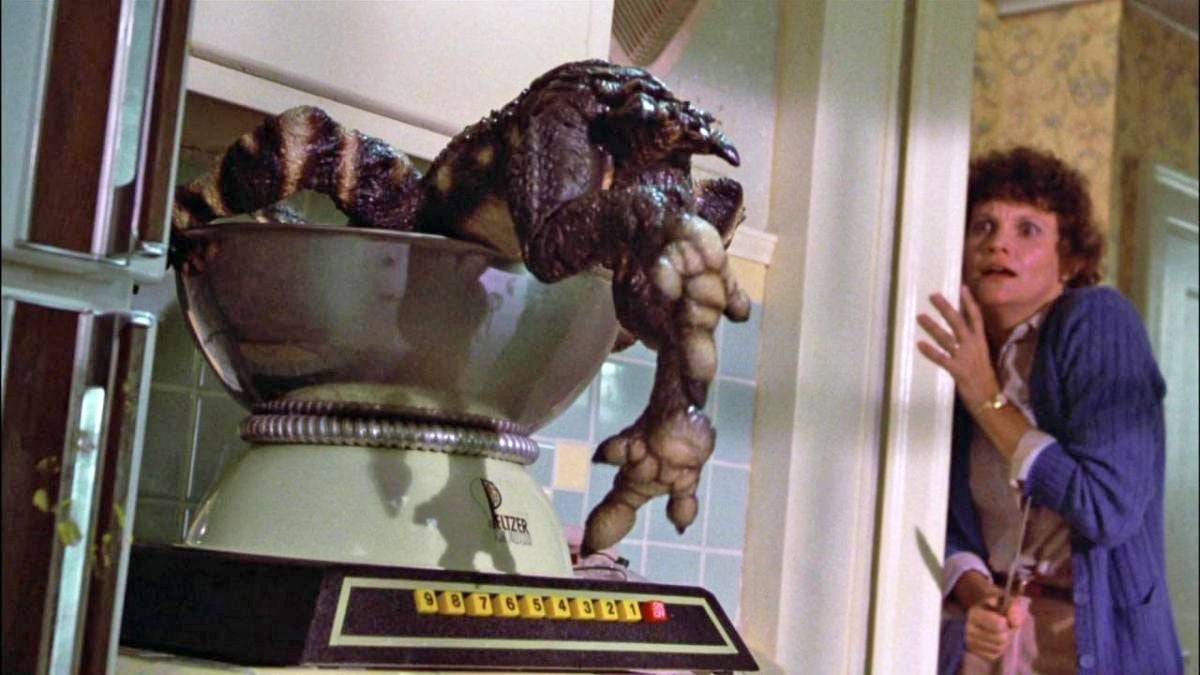
With much of the Gremlins shoot now confined to a controlled environment — a decision obviated by the film’s tremendous amount of on-camera special effects — Hora was faced with basic equipment choices. “On Gremlins,” Hora explains, “I used a Panavision Super PSR, which is a big old Mitchell-based camera inside a Panavision blimp, rather than a Panaflex. This was my personal choice. I had used a Panaflex Gold on the Twilight Zone film, but it was my experience there that a lot of the things I like to do — fast pans and tilting — were a bit more difficult with the Panaflex. For instance, often I will often place a camera on a head crookedly so that as you tilt up or down the picture will go off-level. But the Panaflexes now all have a dovetail base that just snaps together, and you just cannot mount them off-level. My solution on The Twilight Zone for this was to use an adapter to go from the dovetail to the screw and another one for the screw back to the dovetail: but by then the camera was about three feet up from where it should have been.”
As for lenses, Hora points out, “Normally, I try to leave the zoom lens in the truck or as far away as possible from the set and shoot everything in prime. However, on Gremlins, in all honesty, about 50 percent of the film was shot with a Cooke 20-60mm zoom rented from Panavision, which I found to be excellent for our purposes. Although I did carry a full set of prime lenses throughout the shoot, I must say that I found the convenience of the zoom — to dial in 33mm, 37mm, or whatever — very supportive."
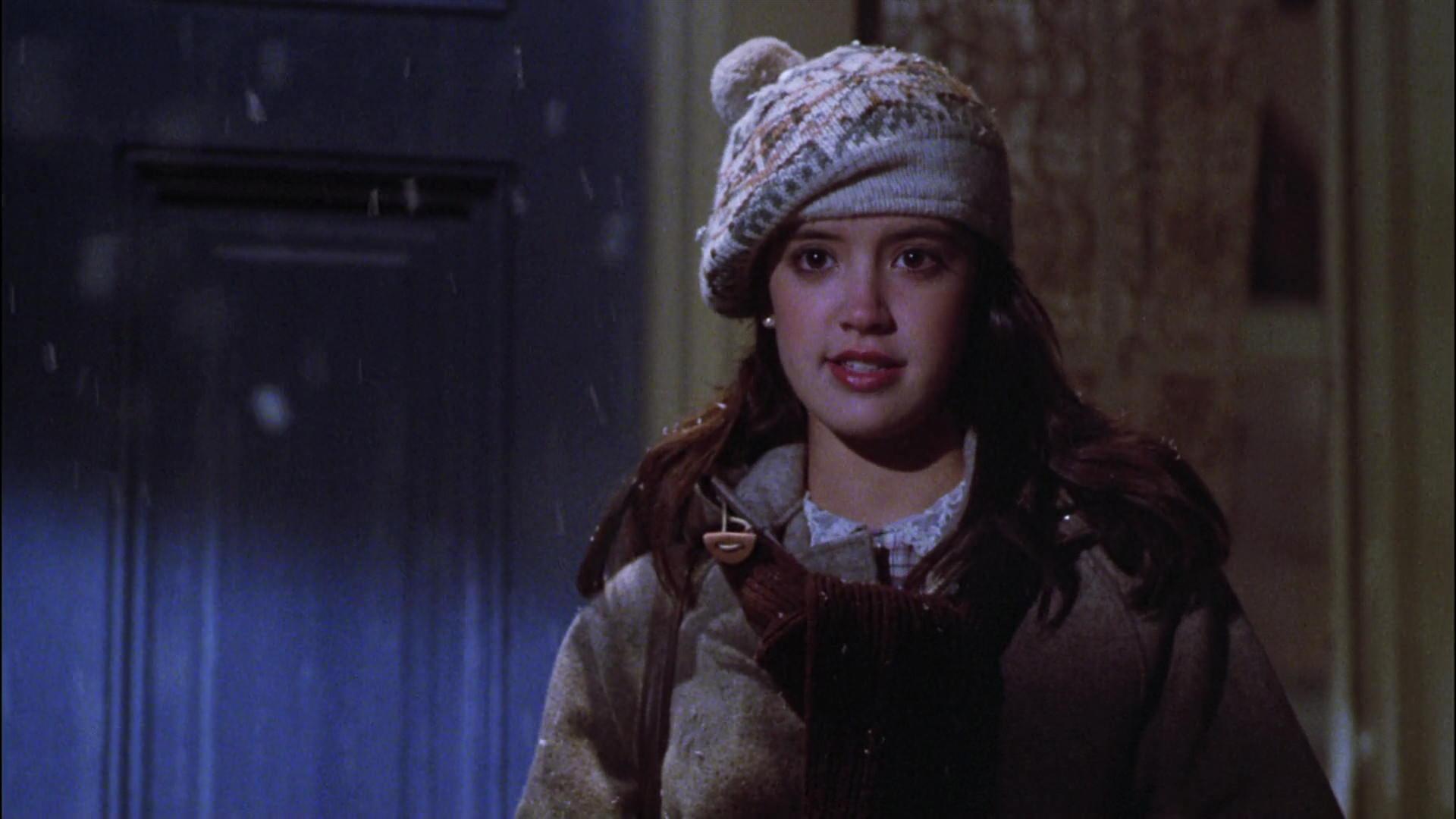
Kodak 5247 was used by Hora to film all the Gremlins exteriors. The film’s interiors were shot using 5293, “just to ease the different field problems and lighting requirements,” as Hora explains it. However, one minor problem did arise with the 93 during the shoot: two-thirds of the way through production, Hora began running out of it. Unwilling to chance completing the filming with Kodak’s then-new 5294 stock (for fear of mismatching grain and contrast), Hora initiated a cross-country search for all existing 93 stock. “We finally located the last 100,000 feet we needed in Hawaii, with the result that every last bit of the interiors were filmed with 5293.”
Hora’s final Gremlins prepping period lay in selecting his crew. This included camera operator Michael Jones and first assistant cameraman Norman Cartel — both of whom Hora has worked with in the past — as well as second assistant Lex Rawlins and gaffer Norman Harris. Now, with the Gremlins generalities behind them, it was time for Dante and Hora to confront the specifics.
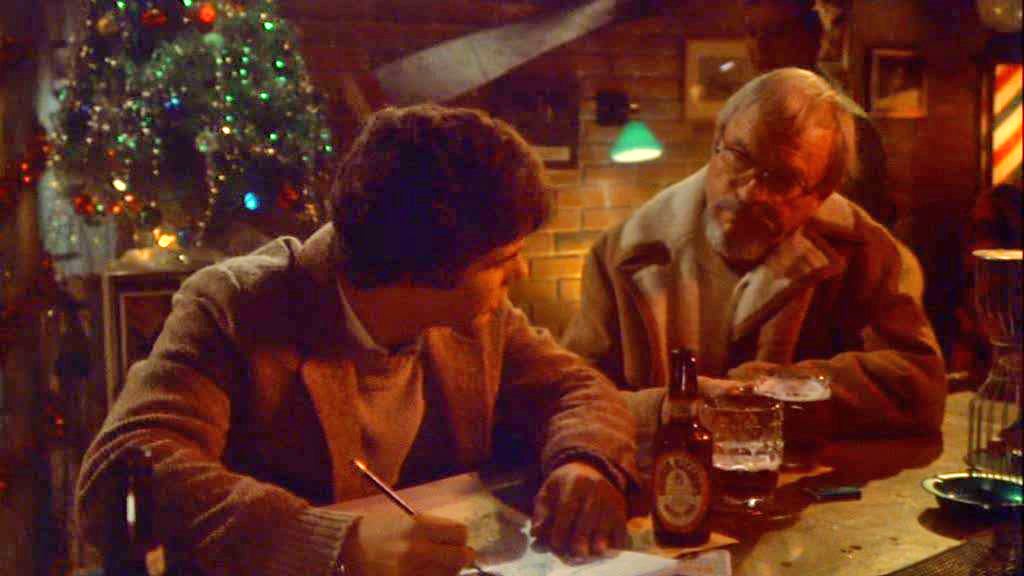
If there is a single word that sets the tone of Gremlins, it is “unreal.” Mixing comedy and horror equally, the look of the production ranges from the realism of the daylit snow-strewn Kingston Falls town square to the comic-book splash-panel type lighting of a boiling YMCA pool at midnight. A fan of many of the old Chuck Jones/Warner Bros. animated films of the 1940s and 1950s, (indeed, Jones makes a cameo appearance in Gremlins in Dorry’s Tavern), Dante decided that Gremlins would also share a richly colored, cartoonish ambiance. “There is a danger when you use bizarre angles and strong colors in a film,” cautions Hora, “and that is that you might come out looking too much like the old Batman television show. Still, my basic nature is to have fun with this sort of approach, and the nature of this story was such that it did not demand a serious approach. Fundamentally, on this film, Joe and I just enjoyed ourselves.”
The cartoonish aspect of Gremlins’ cinematography is immediately apparent in the film's opening sequence, set in a mythical, non-localized Chinatown shot on the Burbank Studios “Tenement Street.”
“Originally,” Hora explains, “this was supposed to take place in Hong Kong, but someone pointed out that it might be a bit difficult to get a gremlin through customs. So after some discussion, we settled on a sort of No-Man’s Chinaland, a rough, fictionalized part of a city with an overheated tropical feel to it, with neon and hookers, a debased, dangerous area where you felt the Tong Wars were just about to break out.”
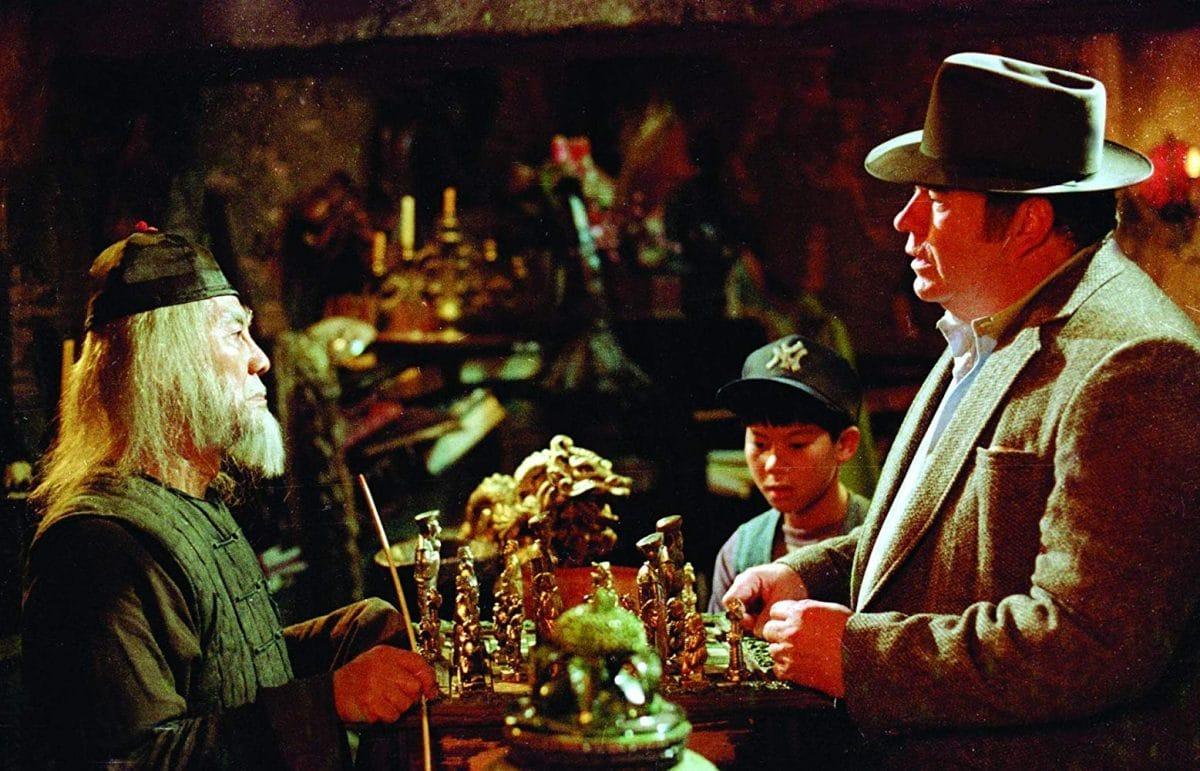
To achieve this “debased” atmosphere Hora relied on heavy backlighting, with lamps that were covered in MT 2 or 85 gel, “sometimes two or three layers of it. The predominant color scheme here was orange and yellow, and we brought all our backlamps up through the haze and mineral-oil smoke that we were also laying in.
"We were particularly concerned with contrasting the hothouse atmosphere of the Chinatown sequences with the snowy New England scenes that were to immediately follow it," Hora continues. “So when we got to the daylit Kingston Falls sections I used an 85C filter and a # 1 Tiffen fog filter on all the nighttime snow sequences, to blue up the shadows and bring out a frosty look. The 85C was particularly handy because of the various materials, including white gypsum sand, Christmas tree flocking, limestone and airport crash foam that were being used to simulate snow during those exterior shots. I found that the 85C tended to put an overall blue cast over the assorted whites, some of which tended to read more yellowish and this was very helpful.”
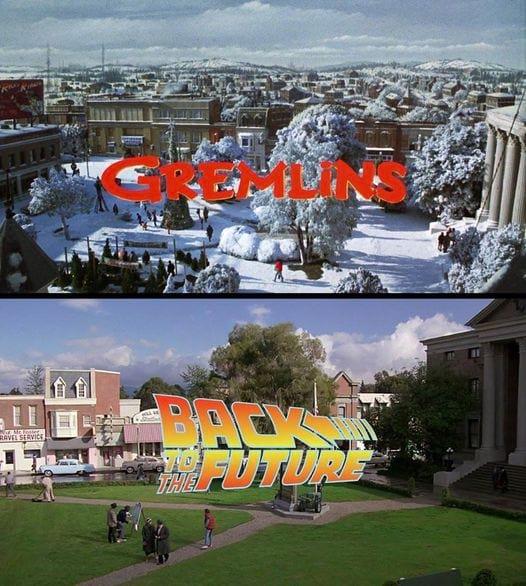
One difficulty faced by the Gremlins crew on the Town Square set did not relate to lighting. Approximately one week before shooting was to begin on the Universal lot, another production company began setting up in the area immediately behind the Town Square Gremlins unit. “And, suddenly, they began erecting all these giant poles and tarps and other paraphernalia right behind our buildings!” Hora recalls. (This tarped-in structure with 85 poles about 60' high is now a permanent addition to the Universal Studios Tour, dubbed “the world’s largest enclosed set” and stretching over New York Street and Brownstone Street.) “These structures went right up into the sky, which meant that we couldn’t shoot the tops of our buildings. We had to shoot around them very carefully, or reverse our angles and in fact, the matte painting [by Dream Quest Images’ Rocco Gioffre] that opens the Kingston Falls sequence even incorporated one of those cables as a part of the painting itself. It was a nightmare; not only did we have to be careful where we shot, but while we were setting up there was continuous construction noise; piledrivers, hammers, shouting. The only quiet moments we had were when we were shooting. It was very, very difficult.”
By this point in the storyline, Billy’s father has brought the boy his pet mogwai home from Chinatown. For Hora, this moment also marked escalating demands on his endurance and ingenuity; as the number of gremlins increased geometrically on the screen, so grew the task of properly lighting them.
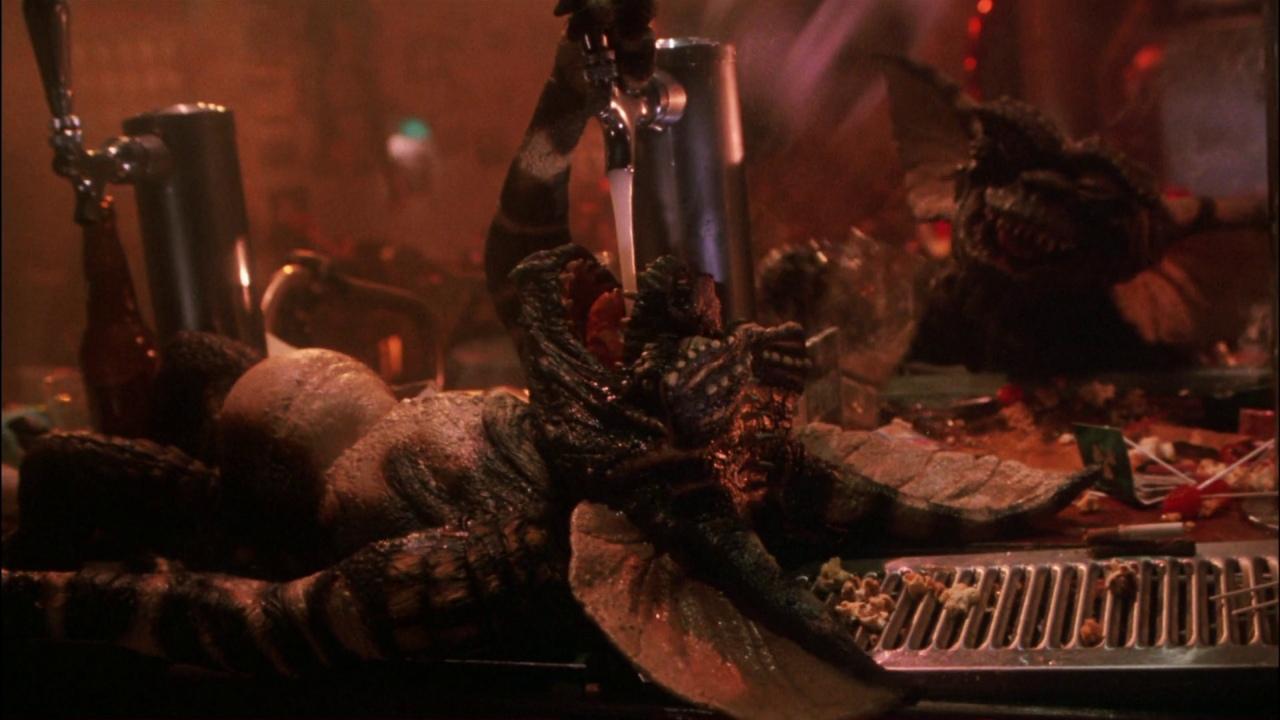
“Luckily,” says Hora, “my background in commercials had prepared me for the great amount of patience you need in dealing with special effects. My work with the foam latex werewolves [makeup effects artist] Rob Bottin designed for The Howling also helped when it came time to do the lighting tests on the gremlins. As they were essentially rubber and much more non-human than Bottin’s werewolves, I found that I had a little more leeway in practically presenting the creatures that Chris Walas had come up with for Gremlins. For instance, I found that simple cross-lighting brought out interesting highlights in the gremlins; I also liked to throw green light on them, because it made them so reptilian. My main concern, particularly with the mogwais, who were the soft, cute versions of the bad gremlins, was to keep hard light and clear-cut shadows off them. We always tried to protect the integrity of these creatures by not highlighting the fact they were essentially puppets and human-operated.”
In addition to lighting natural and supernatural elements, Hora found himself working with the extensive video clips that are scattered throughout Gremlins. A filmmaker who is also a movie buff, Joe Dante had liberally sprinkled his Twilight Zone: The Movie episode with many clips from classic cartoons. Most of these clips were fed directly on set, during filming at the Burbank Studios from an off-camera video command post to the various television sets which were prominently featured in that segment. On Gremlins, Dante once again spotlighted T.V. sets and old clips, this time from films ranging from It’s A Wonderful Life to the 1956 version of Invasion of the Body Snatchers.
In order to assure that the live video Gremlins feeds would not suffer from the rolling shutter bar resulting from video’s 30 frames per second versus films’ 24 fps rate, Joe Unsinn of the Burbank Studios utilized that organization’s TBS 24-frame video system process. In this method, film and/or videos are transferred to a specially designed 24 fps video system; then, the motion picture camera used for filming the shot is locked together with the on-set monitors or T.V. sets used to display the transferred footage. The result is a picture-perfect, synchronized effect.
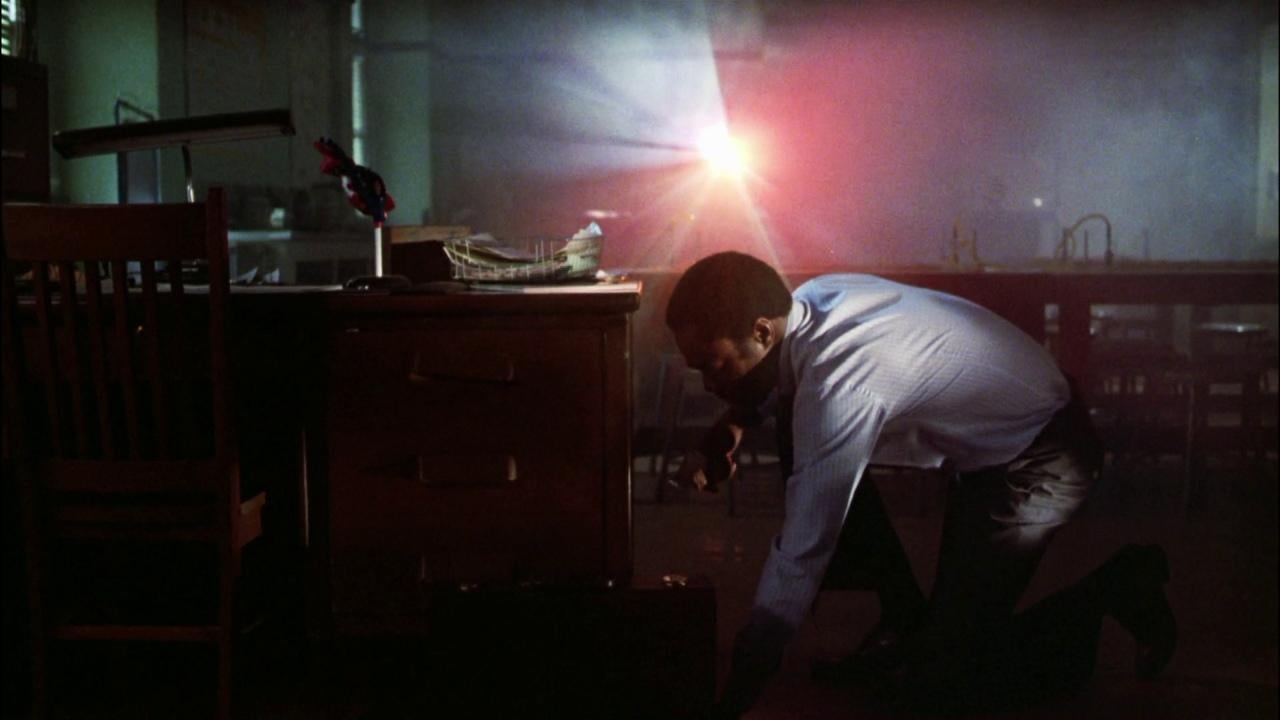
Another example of synchronization occurs during a sequence set in a darkened biology lab. Schoolteacher Roy Hanson (Glynn Turman) is searching for a transformed mogwai in the empty classroom while, behind him, a clip from the 1950’s educational film Hemo The Magnificent (starring veteran actor Richard Carlson and concerning blood and the heart) is being played backward on a 16mm projector. To enhance the low-key moodiness of the scene, yet still retain a colorful highlight, Hora aligned his 35mm camera so that during most of the shots, the 16mm projector is actually casting its beams directly into the camera’s lens. The result is a delicate fanning effect of prismatic light which adds a touch of beauty to an otherwise mysterious scene.
For all of the inventiveness and sheer number of effects involved in Gremlins, two sequences, in particular, are standouts. One of these is the by-now famous kitchen scene, wherein Mrs. Peltzer (Frances Lee McCain) hacks, bakes and purees a number of marauding gremlins by using such commonplace domestic tools as a food processor and microwave oven. Although Hora himself dubs the action “gruesome,” there are also subtle touches within the kitchen scene that add to its overall effectiveness.
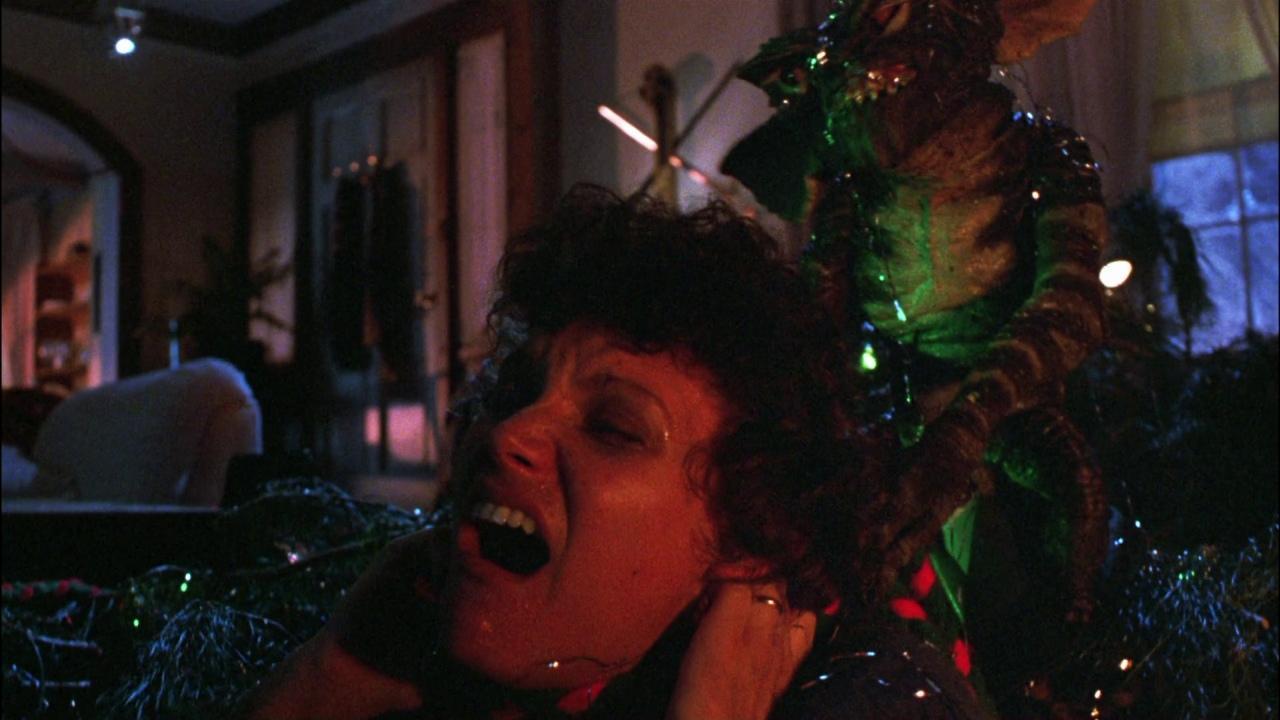
“For instance,” Hora says, “while Billy’s mother is walking down the hallway towards the kitchen there’s a moment when she turns her head, and just out of her line of vision there’s a quick gremlin shadow on the wall behind her. That, I think, added a lot to the scene without forcing any real additional work on us.
“Frankly, my contribution to the kitchen scene, in the creative sense, was far less than Joe’s or Chris’ or Bob MacDonald’s, the special floor effects supervisor. One detail that seems to have escaped everyone, though, happens during the shot when Billy’s mother is looking into the kitchen and you see one of the gremlins climb up into the blender. No matter what the puppeteers tried to do they couldn’t get him to climb up. So that gremlin actually climbs down, and we shot it backward. No one seems to notice that. But if you watch the mother’s reaction closely during that shot, you have to laugh; Frances looks crazy. No matter how much she tried to act backward, there are just certain things you cannot do with your eyelids, and the whole shot has a very uncanny quality.”
“Uncanny” would also describe the spectacular “boiling pool” sequence. Escaping from the pursuing Billy, the last remaining gremlin leaps into a deserted YMCA swimming pool — which immediately begins to boil and bubble as hundreds of new gremlins are born underwater. This was one of the most complicated floor effects sequences in the film, one requiring that Walas and MacDonald’s team first shoot a sinking gremlin puppet (holding its nose) in a clear-sided water tank. Bob MacDonald Sr. and Bob MacDonald Jr. (Gremlins special effects foreman) then spent a week and a half rigging the Columbia Ranch pool with bottles of immersed liquid nitrogen and underwater compressed air feed lines which, when opened, produced a tremendous agitation, as well as vapors breaking out over the pool’s surface. Hora added to the effect by placing large waterproof lights — “big, godawful things, like airport runway lamps” — and large jelled flashbulbs in watertight containers in scattered positions on the pool’s bottom and near the surface of the water. When triggered, these lights produced a number of bright random flashes, greatly enhancing the scene. “The racket and vibrations from the nitrogen boiling through the pool was unbelievable,” Hora comments. “In fact, the ground was shaking.
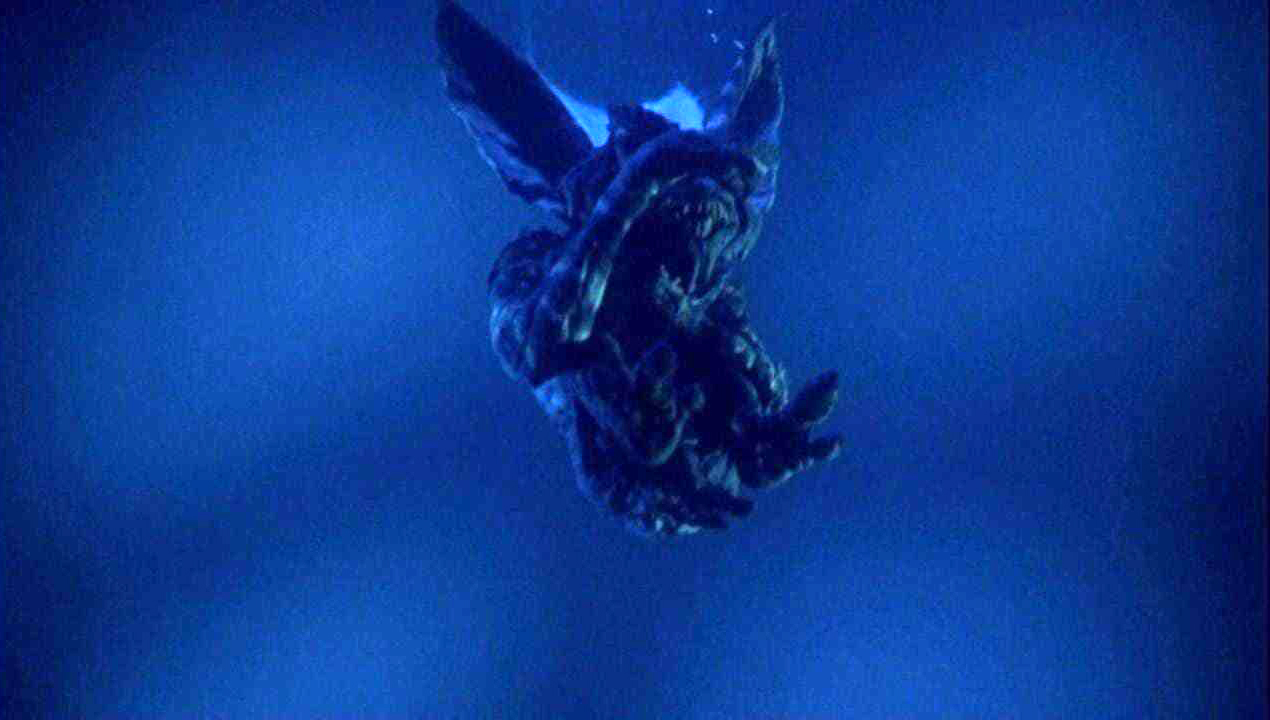
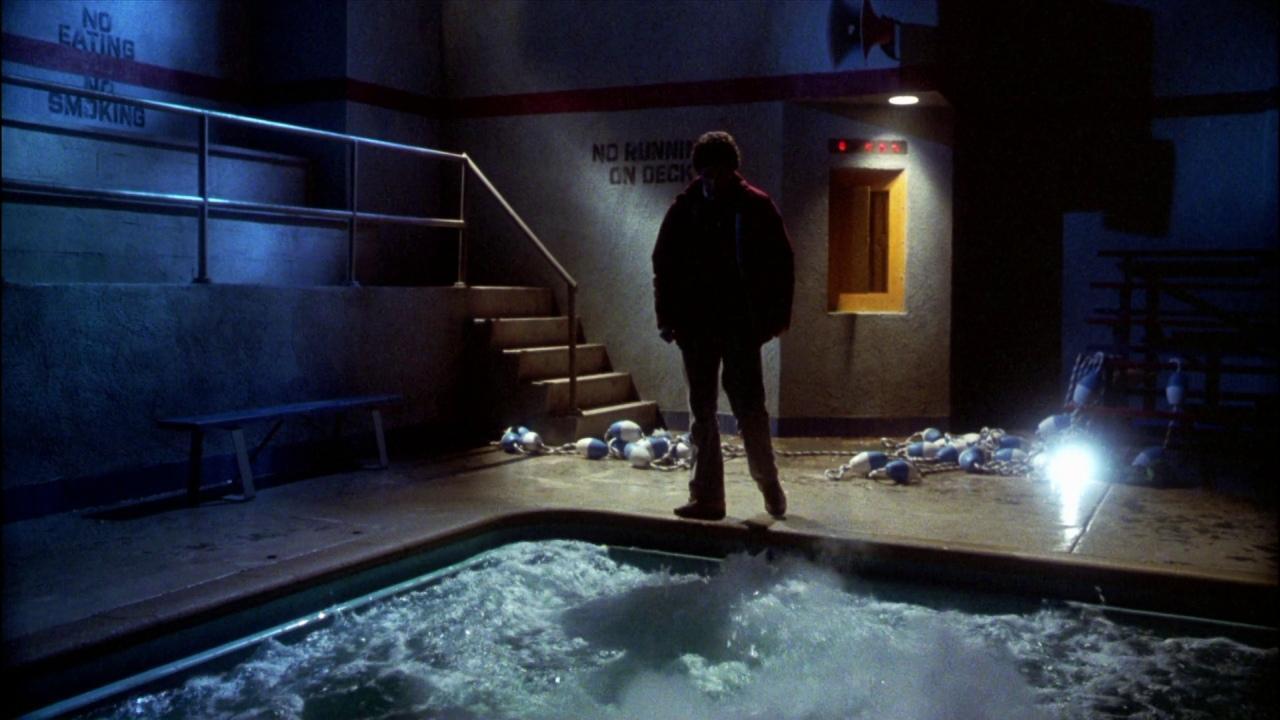
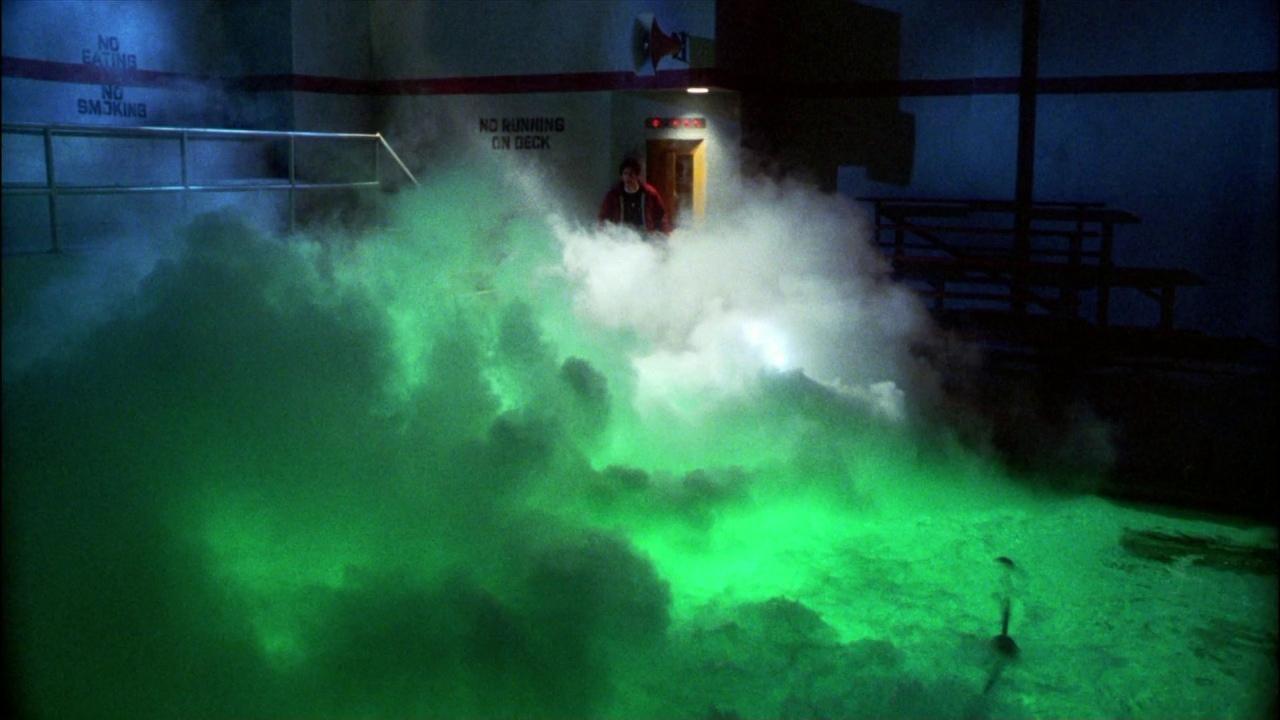
“The pool sequence also illustrated one of the problems we had to constantly deal with on this film,” adds Hora, “That is, much of Gremlins was not shot at 24 fps, which seems to be a procedure I’m specializing in with Joe after our last three projects together. For example, after Billy sees the pool boiling and runs out of the YMCA, you see lights flickering behind him. This was all shot at 24 fps. But the moment he leaves the frame the camera drops down to 12 fps, with the resulting light agitation becoming faster and faster. When you go off speed like that, you immediately have the same problem you get with fluorescent lights and HMI flicker.
“Most lights rise and dip a bit at 60 cycle current flows, but at 24 fps you don’t detect it on film, but lower that frame rate and you can get a notable pulsating effect from certain lights, especially HMIs, which are AC-captive arc lights about ¼ the size of an arc lamp. So we had to be very careful whenever we were going to variable speeds; thankfully, Norm Cattell, as long as he has one hand on the speed control and one hand on the F-number, can always accommodate frame changes with no apparent exposure change.' For some reason, HMI flicker, which is quite noticeable if you dip a few frames below 24 fps with 180 degrees of shutter, levels out and disappears at 15 fps.”
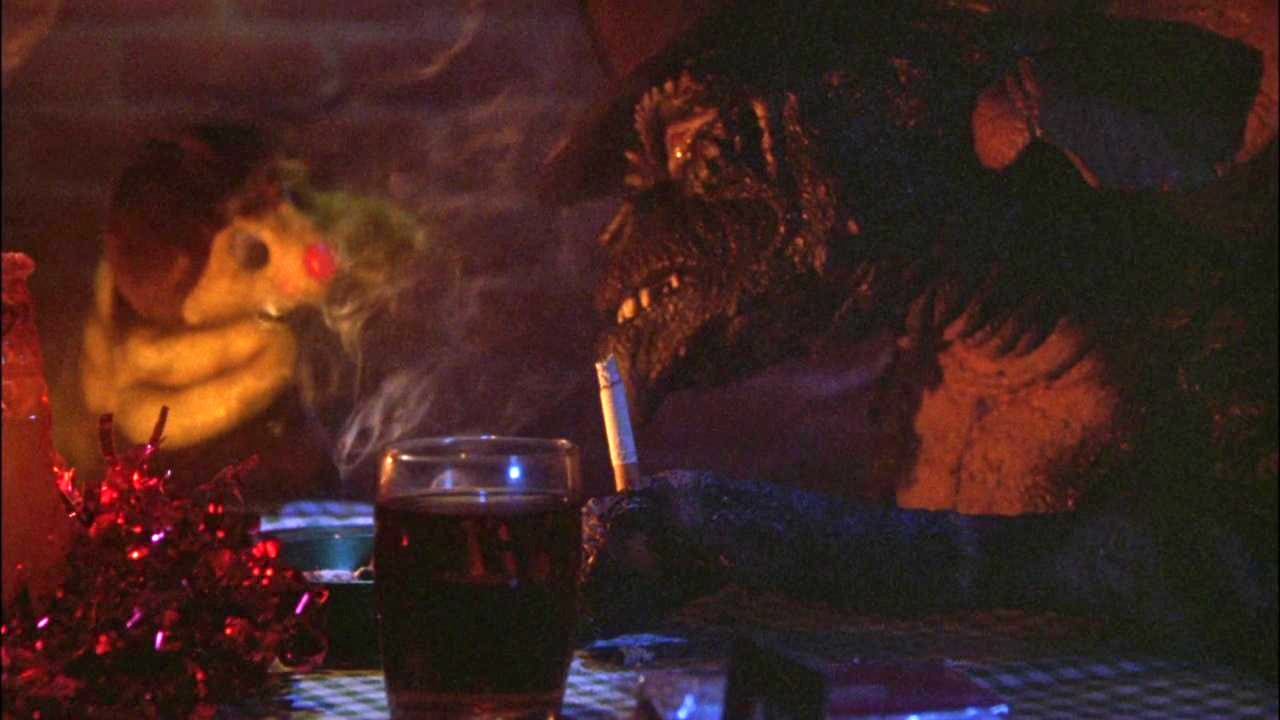
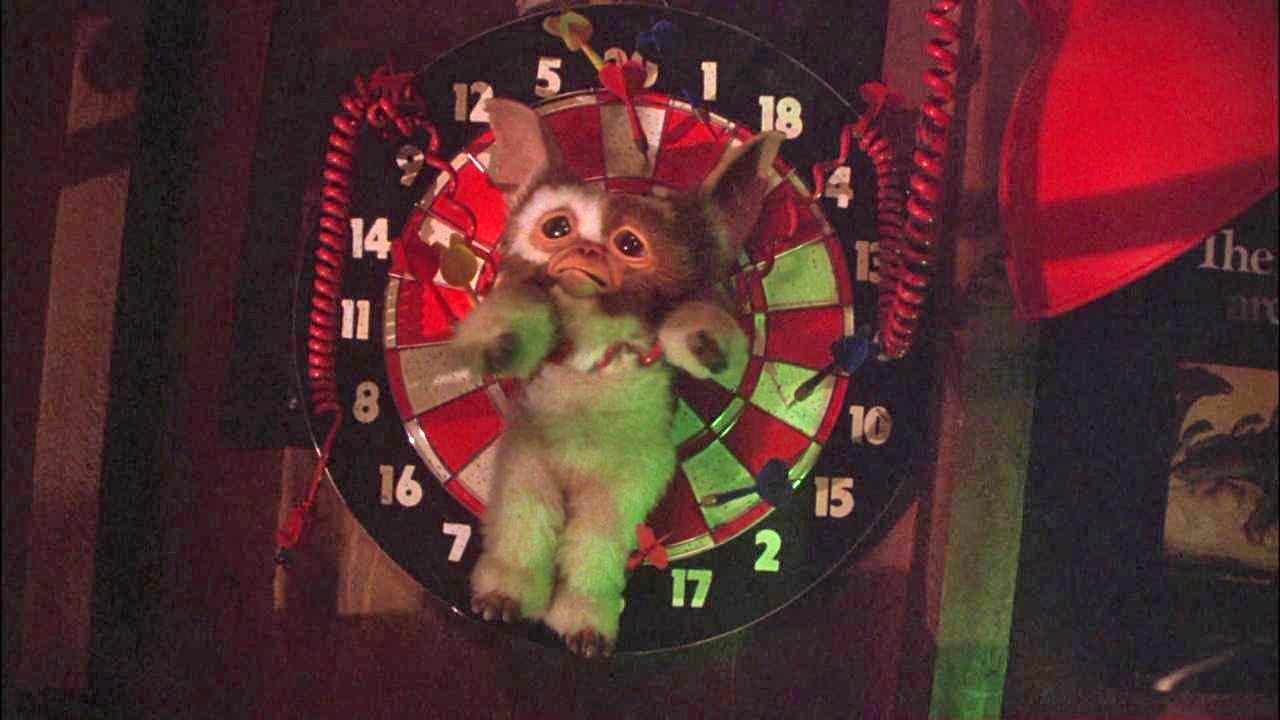
Spectacular as the pool sequence may be, it’s the tavern scene, like the kitchen sequence before it, which is Gremlins second high point. Drinking beer, cheating at cards, picking their noses and terrorizing young waitress Kate (Phoebe Cates), the gremlins congregate in Dorry’s Tavern for an outlandish high-tech creature party. This was one of the most complicated (and exhausting) segments for Walas’ gremlin crew, as well as the most varied lighting assignment for John Hora.
“There are virtually all of the primary colors involved in Dorry’s Tavern,” explains Hora, “colors which we used for fill, key, and side lighting. Yet I actually tried to be as unspecific as possible when dealing with the secondary light sources in that bar; the neon signs, Christmas tree lights and so on. I talked to Norm Harris and his best boy Ron Kenyon in terms of the general impression you would get on the screen, and also pointed out such details as not letting the lights flare out. Then Norm and Ron went into the tavern set and spent a good five days pre-rigging all the signs and lighting flashes and so forth that were going to happen in there.
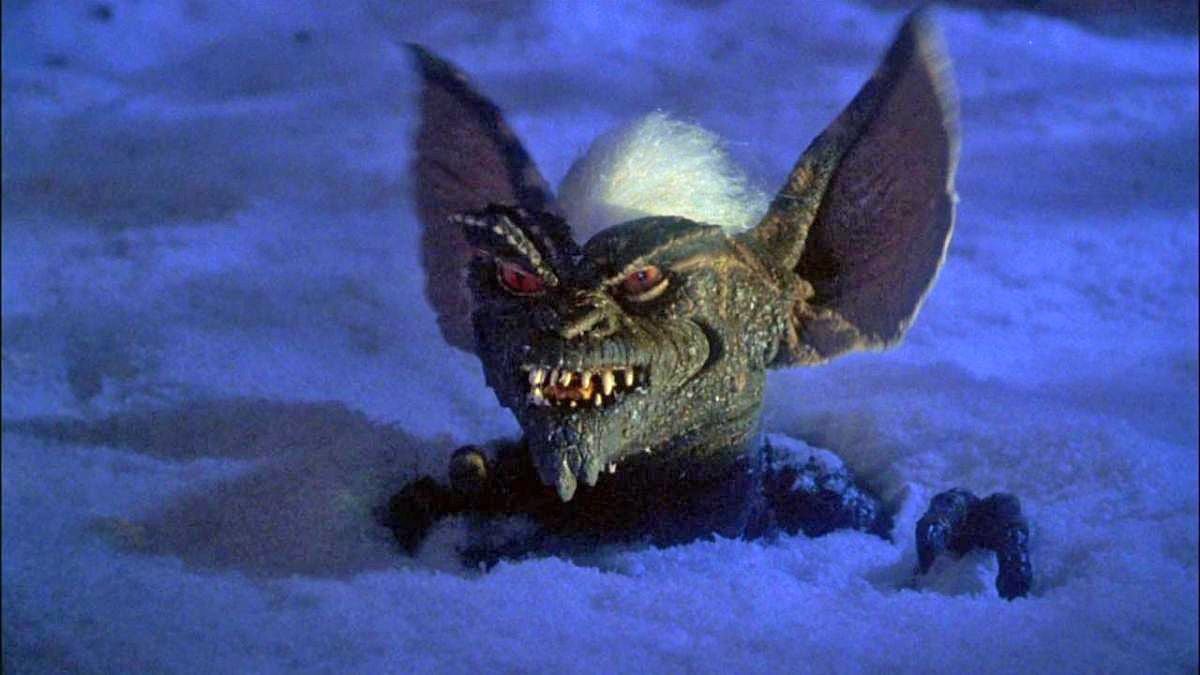
“Then we shot it. The scenes with Phoebe were done as part of the principal photography; then we went back and spent another week in post with Chris Walas and his crew, which numbered upwards of 30 people for some shots.”
Throughout the Dorry’s Tavern sequence Norm Harris provided, according to Hora, “a general overall fill which Norm habitually puts over every set; he has worked out a system whereby he can just dial in some soft, top ambient light. As for our secondary light sources, we figured that there were so many of them — beer signs and jukeboxes and holiday lights — that we could take a lot of liberties there. If we wanted to add some purple highlights we’d ask Joe about it and he’d usually say, ‘Yeah, purple, sounds good.’”
One secondary light source in particular, however, found itself becoming a major annoyance. “There was a big Coors sign in Dorry’s that, no matter what we were shooting, always seemed to be dead center in every composition” explained Hora. “Just like a bullseye. We kept spraying it down darker and darker. Finally, we were so disgusted with it that when Bob MacDonald came up with the rig that flew the gremlin off the overhead fan — which we also, incidentally, shot at decreasing frame rates within the shot itself — we had him aim it at the Coors sign. And the gremlin just destroyed it. That was very satisfying, I can tell you.”
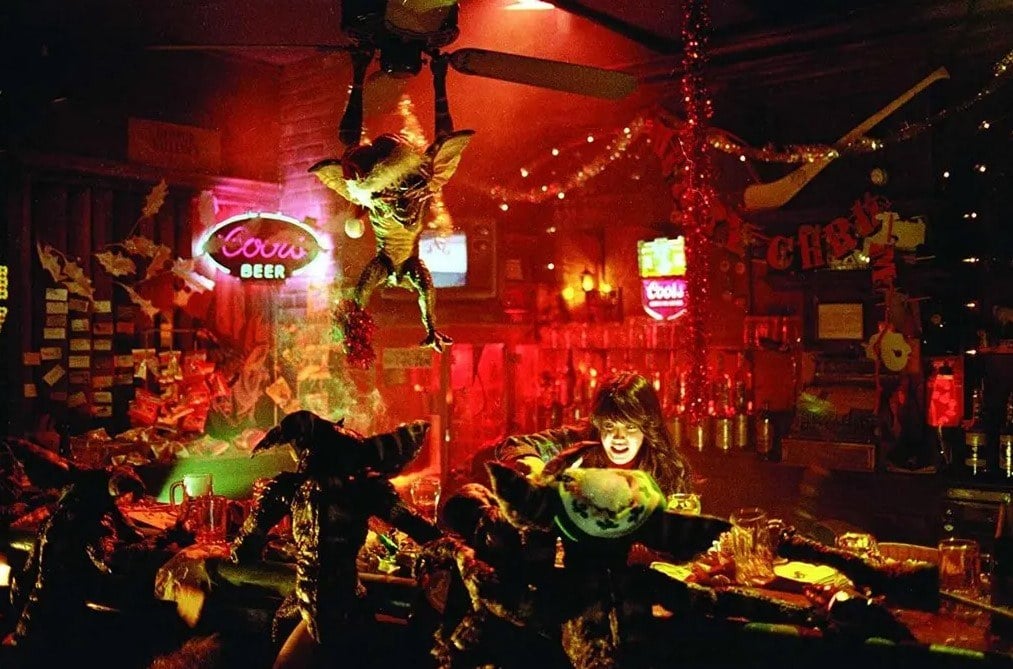
MacDonald also contributed to the atmospheric moments when Billy and Kate, having escaped from the tavern and finding brief sanctuary in the local bank, then return to the outside world. They encounter a smoky, deserted Main Street, one with the “desolate feel of the empty streets of Los Angeles after the Martian attack in The War of the Worlds" according to Hora. Tracking the swarms of gremlins down to the town’s small local theatre, Kate and Billy discover the creatures are putting a whole new spin into the meaning of The Late Show — the entire gremlin population of Kingston Falls is packed into the auditorium watching a very special Midnight Movie screening of Snow White and the Seven Dwarfs.
“The Gremlins company’s arrangement with the Disney people was such that they were only allowed to use a very small piece of Snow White," Hora explains. “So we were very selective in our cuts when we used that clip. Actually, we had two prints of the same sequence, one at 3200 Kelvin, which was a normal one balanced for an incandescent light projection source and one at 6000 Kelvin. But our own final print was so warm — we had done a few balance tests for an arclamp light source, previous to shooting it — that we went with the cold Snow White print. It looks warm even the way it is.
“Technically,” Hora continues, “my end of the Snow White shoot was fairly straightforward.” Although Hora did suggest that Walas’ puppeteering crew attach gremlin puppets to bicycle helmets then worn by the operators, a suggestion taken up and allowing one extra creature to be manipulated by each puppeteer in the theatre. “This was done during principal photography, and the Disney clips were shot live on the Burbank lot movie house set as we were filming. In order to keep the projector and our camera in sync, we used a system developed by Bill Hansard, who has made a specialty out of processed rear and front projection photography. By locking the phase of the crystal motors together and running a simple wire between our camera and his equipment, we were able to keep the two shutters in sync so that we were always photographing the period when the Snow White picture was on the screen, even at reduced camera speeds.
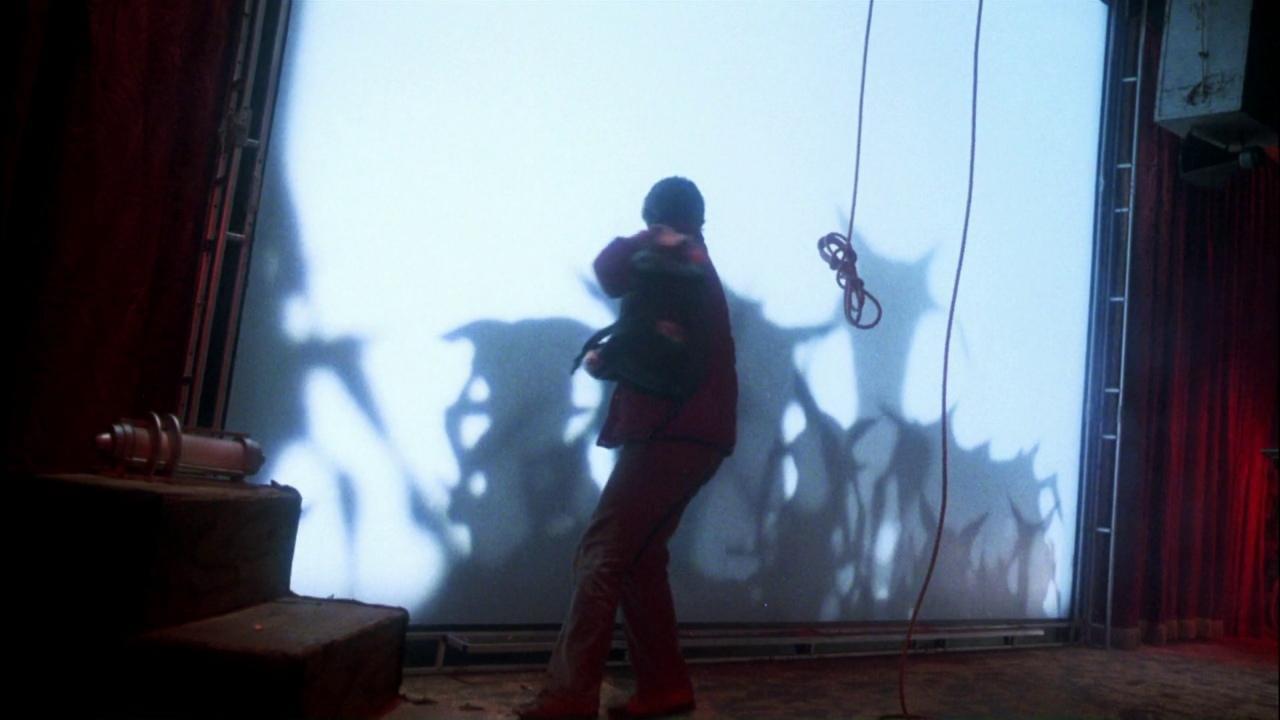
“We were also fortunate enough to get hold of a double screen which Hansard had recently used on a project. This allowed us to shoot either side of the screen, as either front or rear projection. When you’re in the back of the theatre looking over the gremlins you’re actually seeing a frontally projected image, and when you’re behind the screen, you’re actually seeing a rear projection. There was very little light or image quality drop-off on that screen, no black backing or thick white paint on the back of it to cut down on the intensity of the image. As for the growing gremlin shadows on the screen that start to chase Kate and Billy as they’re leaving the theater, those were animated effects supplied by Peter Kuran of Visual Concepts Engineering.”
With the majority of the gremlins dispatched in an explosion at the theater, and the leading gremlin killed after a wild chase in a department store (during which inserts of a “Superface” mogwai — so called because of its larger dimensions and facility of facial expressions — were filmed in a large, radio-controlled car set against a small rear-projection screen), peace at last falls again on Kingston Falls.
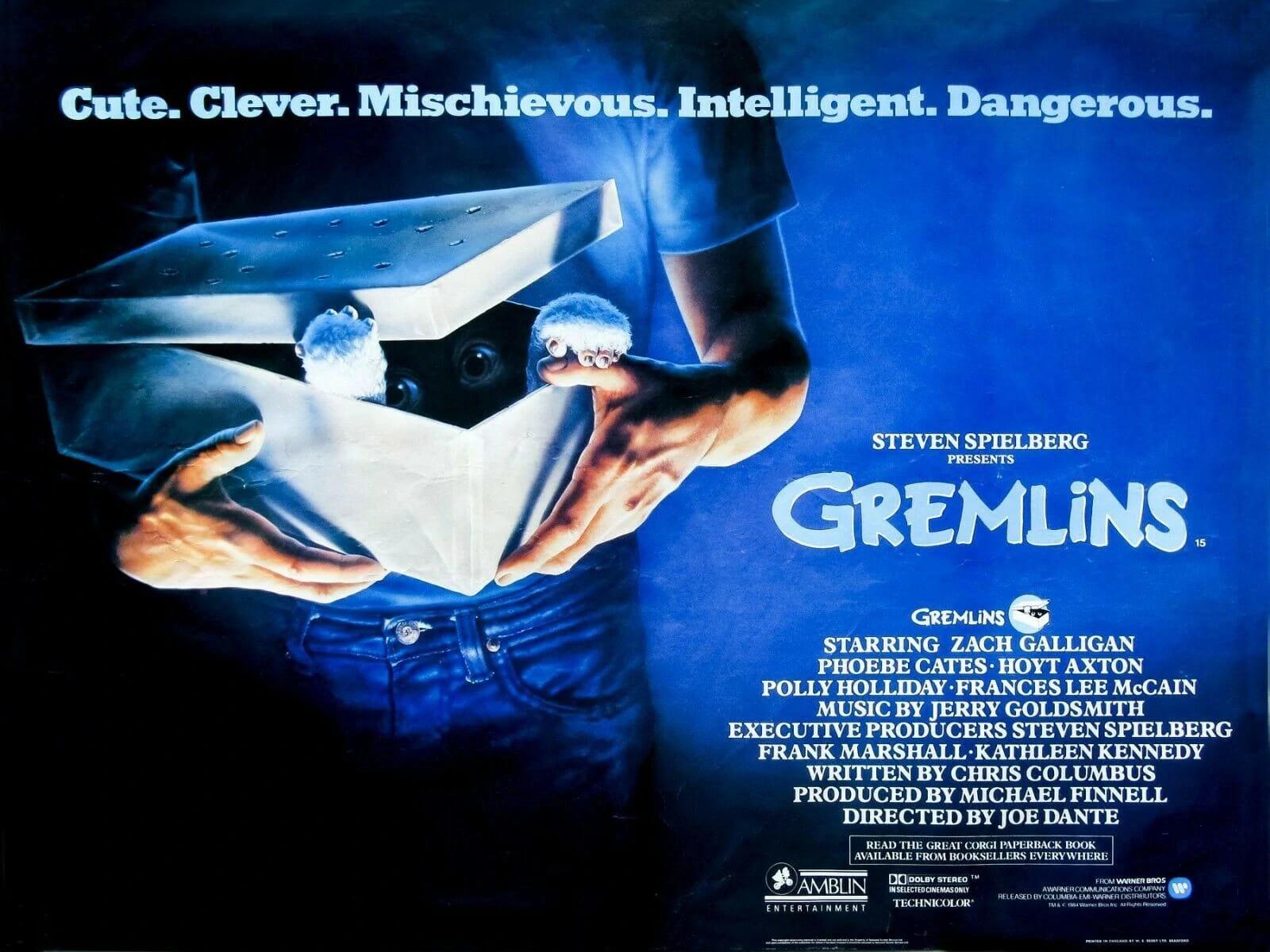
One of the final shots of the film shows the entire Peltzer family out on the porch of their home, a night shot distinguished by its warmth. It is one of the warmest shots in the film, but “paradoxically,” Hora adds, “what I think sells that shot is the very deep, cold, blue correction on the arcs in there, something that’s become sort of my trademark moonlight effect. Even with layers of cold blue gel on our lights, that moonlight goes way deep down in the shadows and doesn’t look overly menacing. In fact, I think it’s a very friendly kind of cold light.”
After spending nearly a year on his most complex assignment to date, Hora has nothing but praise for his Gremlins coworkers. “When you actually see the final product, when all the tricks and voices and music come together and make you actually believe that you’re seeing real creatures up there on the screen, instead of 15 people on the floor of the set pulling cables, well, it’s quite a feeling.”
Hora became a member of the ASC in 1985, and would go on to collaborate with Dante on the features Explorers (1985), Gremlins 2: The New Batch (1990) and Matinee (1990).






